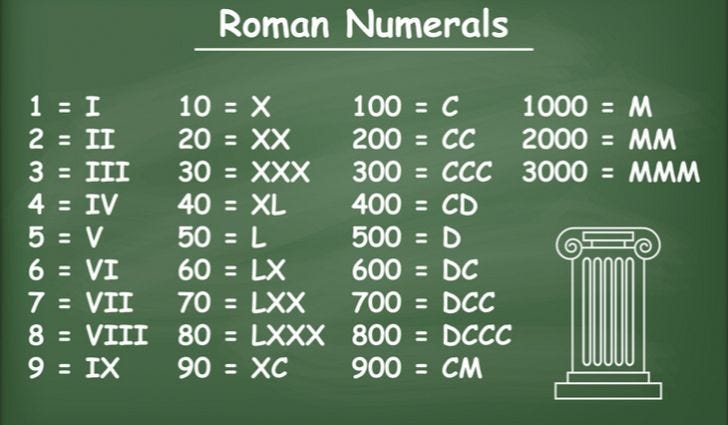Leetcode 13 — Roman to Integer
 Ved Asole
Ved Asole
Question Link : Roman to Integer
Problem Statement :
Roman numerals are represented by seven different symbols: I, V, X, L, C, D and M.
Symbol Value
I 1
V 5
X 10
L 50
C 100
D 500
M 1000
For example, 2 is written as II in Roman numeral, just two ones added together. 12 is written as XII, which is simply X + II. The number 27 is written as XXVII, which is XX + V + II.
Roman numerals are usually written largest to smallest from left to right. However, the numeral for four is not IIII. Instead, the number four is written as IV. Because the one is before the five we subtract it making four. The same principle applies to the number nine, which is written as IX. There are six instances where subtraction is used:
Ican be placed beforeV(5) andX(10) to make 4 and 9.Xcan be placed beforeL(50) andC(100) to make 40 and 90.Ccan be placed beforeD(500) andM(1000) to make 400 and 900.
Given a roman numeral, convert it to an integer.
Example 1:
Input: s = "III"
Output: 3
Explanation: III = 3.
Example 2:
Input: s = "LVIII"
Output: 58
Explanation: L = 50, V= 5, III = 3.
Example 3:
Input: s = "MCMXCIV"
Output: 1994
Explanation: M = 1000, CM = 900, XC = 90 and IV = 4.
Constraints:
1 <= s.length <= 15scontains only the characters('I', 'V', 'X', 'L', 'C', 'D', 'M').- It is guaranteed that
sis a valid roman numeral in the range[1, 3999].
Solution:
Approach : Comparing the roman numbers with the next one
Firstly, we will implement the switch statements to calculate and get the value of the roman numberals. Then we will take integer value of each roman numberal from the input string and compare it with the integer value of the next roman numeral. If the next roman numberal is greater than the previous one then we will substract it from the total sum otherwise we will add it to the sum.
Explanation :
Before running the logic for the program, we used the System.gc() command to run the garbage collector in java and release the memory.
Now, we will define four variables as below :
sum= total sum of the integer values of each roman numeralnum= the current roman numeral value in the iteration.next= the next roman numeral value after the current number.strLength= the length of the roman number.
Note: We are defining variable for the string length outside the for loop so that the program only checks the length 1 time for the string. If we check the string length inside the for loop codition then it will check the String length for every iteration.
Now, we will use for loop to iterate over each character(roman numeral) in the roman number string. We will define a switch which will check the current index character and will assign it’s integral value to num variable. Similarly, the 2nd switch is defined for getting the integral value of the next character from the roman number string and store it in the next variable. Before the 2nd switch statement, we check if the current value of the iteration index is not the same as strLength— 1as it will cause an ArrayIndexOutOfBound Exception for the last iteration when there will be no next numeral.
Now, after getting the values of both the current and next roman numerals, we will check if the current number is less than next. If it’s less than next number then it means that we need to subtract that numeral value from the next roman number value or the sum . Else we can directly add the current number value to the sum variable.
Finally, at the end of the program we will return the total sum.
Performance :

Code :
class Solution {
static {
System.gc();
}
public int romanToInt(String s) {
int sum=0;
int num=0;
int next=0;
int strLength=s.length();
for(int i=0; i<strLength;i++){
switch(s.charAt(i)){
case 'I' -> num = 1;
case 'V' -> num = 5;
case 'X' -> num = 10;
case 'L' -> num = 50;
case 'C' -> num = 100;
case 'D' -> num = 500;
case 'M' -> num = 1000;
}
if(i<strLength-1){
switch(s.charAt(i+1)){
case 'I' -> next = 1;
case 'V' -> next = 5;
case 'X' -> next = 10;
case 'L' -> next = 50;
case 'C' -> next = 100;
case 'D' -> next = 500;
case 'M' -> next = 1000;
}
}
if(num < next) sum-=num;
else sum+=num;
}
return sum;
}
}
Subscribe to my newsletter
Read articles from Ved Asole directly inside your inbox. Subscribe to the newsletter, and don't miss out.
Written by

Ved Asole
Ved Asole
I am a passionate Software Engineer with three years of experience in building modern, scalable software solutions. I have a strong interest in cloud computing, microservices, and full-stack development. My certifications in AWS Cloud Practitioner and Azure Fundamentals reflect my dedication to mastering cloud technologies and staying current in this rapidly evolving field. In my role at HCL Tech, I have developed backend services using Java Spring Boot and implemented React-based frontend components, optimizing application performance by 10-15%. I’ve also worked on reducing API response times by 20% and enhancing system reliability with a 5% reduction in downtime. My expertise spans across cloud platforms like AWS and Azure, where I’ve contributed to the scalability and efficiency of various systems. I am proud to have been recognized with the Livewire R&R Award for my impactful performance improvements. Looking forward, I aim to further refine my skills in full-stack development and cloud-native architectures, focusing on building resilient and scalable systems. I am excited to explore emerging technologies like AI and DevOps to contribute to innovative projects and drive future success.